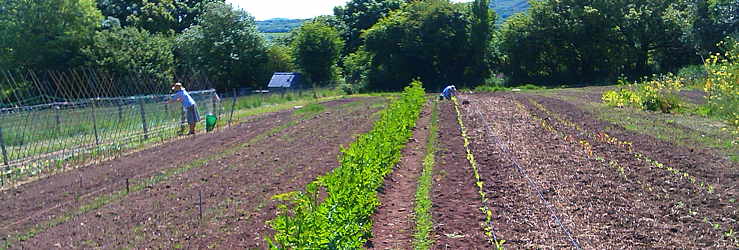Our Ever-Popular selection of Easy Oriental Greens
Delicious both cooked or raw in salads
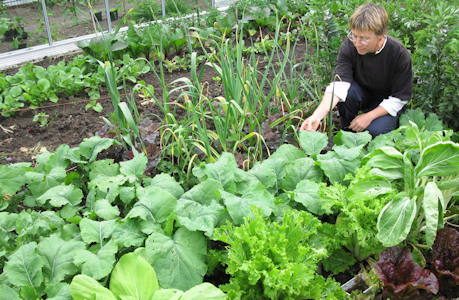
These quick and tasty greens are sown after midsummer - a time often overlooked by home gardeners. They keep your plot going through late summer, autumn, winter and the springtime hungry gap.
Do give them a go – this has become the biggest-selling part of the catalogue, and once people have tried them they come back for more & more - and especially useful if you don't have the space for traditional winter veg like sprouts and broccoli.
If you're wondering how to cook them, these are incredibly versatile and to be honest you just can't go wrong – they are nice raw in salads, cooked alone, or mixed in with any favourite recipe.
These are cool-weather plants. Normally sow in very early spring, or after midsummer. In hot weather most will just flower when tiny rather than growing leaves.
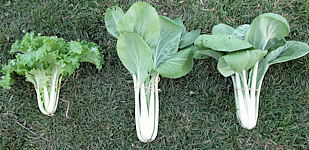
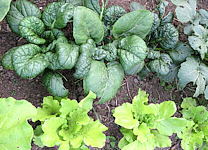
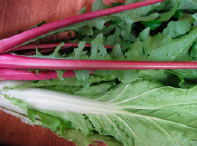
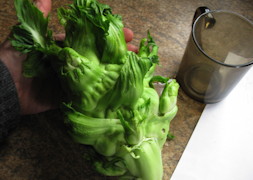 Wa Wa Ga Choi Stem Vegetable (a.k.a. "The Thing")
Wa Wa Ga Choi Stem Vegetable (a.k.a. "The Thing")
So, definitely our strangest vegetable. And it is really, really good! Zha Cai is a unique sort of plant from Szechuan in China, where it is famous. How on earth to describe it?
The stem is swells up like a kohl-rabi but making lots of bumps rather than one big one. The stem and leaves can be used sliced in salads, cooked, pickled or stirfried. The flavour is delicious, savoury and somewhat - but not very - spicy.
However, slightly tricky timing-wise: If sown in Spring it will just bolt – instead, sow in September for overwintering, or sow VERY early right at the start of Spring under cover.
It makes leaves quite quickly, say 4 or five weeks to a reasonable plant size; then it makes the swollen stem which should be ready roughly 3 months later.
When we grow it outdoors it doesn't make the knobbly bits. So for now we recommend a greenhouse or polytunnel only, grown overwinter.
 approx 200 seed, organic £
approx 200 seed, organic £
Small screen: Turn your device sideways to view sowing calendar.




















































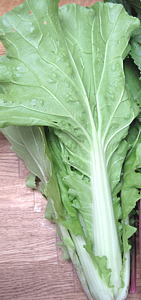 'Michilli' Chinese Green SPECIAL PRICE
'Michilli' Chinese Green SPECIAL PRICE
A fast-growing, pale green, upright 'chinese cabbage' that has white ribs. If you don't know this vegetable, it's not at all 'cabbagey' - its actually a completely seperate subspecies, with a very mild flavour, and is used used in salad or cooked. You might recognise this as the yummy pale green-white bits in chinese take-away noodles with vegetables.
The picture shows a young plant, they become more cylindrical as they get bigger.
Upright Chinese green, great cooked or raw, keeps well once cut. Easy.
![]() approx 400 seed
£
approx 400 seed
£
Small screen: Turn your device sideways to view sowing calendar.




















































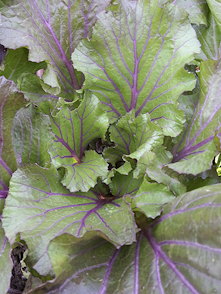 "Vibrant Joy" Purple Pak-Choi
"Vibrant Joy" Purple Pak-Choi
An amazing new variety from plant-breeder Frank Morton, with vibrant shades of magenta, violet, purple, and rose pink on the petioles, sometimes the leaf veins, and sometimes the entire leaf.
Colour saturation is best with cold weather, so recommended planting is in September. Tunnel plantings Jan-Feb should also colour well.

 250 seed
£
250 seed
£
Small screen: Turn your device sideways to view sowing calendar.






















































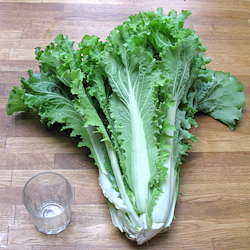 'Bekana' Chinese Salad "Cabbage"
'Bekana' Chinese Salad "Cabbage"
Bekana is a very quick growing oriental green that makes large open heads of pale green leaves.
Don't be put off by the name. This fantastic plant isn't a cabbage at all; it’s shaped like a Pak Choi with long white stems and gently wavy leaves. It has juicy white midribs that you will recognise as the yummy bits from your chinese takeaways, and the tender leaves have an excellent flavour.
It is quick to grow even from a Spring sowing and has a great flavour raw in salads, or cooked as a green.
Particularly tasty stir-fried, also good for winter & early spring salad stuff.

 - approx 300 seed
£
- approx 300 seed
£
Small screen: Turn your device sideways to view sowing calendar.




















































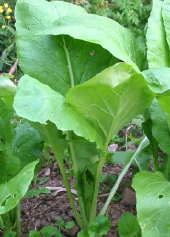 "Komatsuna" Japanese Green
"Komatsuna" Japanese Green
Komatsuna is an incredibly versatile green from Japan and Korea with leaves used as a cooking leaf like Kale or Chard, or used raw in salads.
It is delicious, cold tolerant and easy to grow all year - you get small plants after about 30 days, or bigger after about 70 days - and you can harvest at any time.
There are so many ways to grow this, you can't really go wrong:
- Either sow direct - or in a seedbed, or in pots and then plant out.
- You can sow several times from spring to autumn.
- The main sowings are in spring and summer.
- You can also sow in late summer/autumn under cover and they will grow overwinter in an unheated polytunnel or greenhouse
So the easiet thing is to sow in a drill about 5cm apart and then progressively thin to about 45cm apart as the plants get bigger, eating the thinnings as you go.
The plant is not only delicious, but also drought and cold resistant.
![]() - approx 200 seed
£
- approx 200 seed
£
Small screen: Turn your device sideways to view sowing calendar.




















































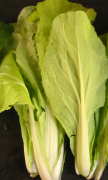
 "Santoh" Quick Yellow Pak Choi
"Santoh" Quick Yellow Pak Choi
A very fast growing pak choi from Japan, this has very pale green (almost true yellow) rounded leaves that can be harvested as soon as just one month after sowing.
This did really well in our 2008 salad trials, and has been a favourite ever since. It is excellent both cooked and in salads.
The great thing about this variety is that it is very quick, and resistant to bolting. Most pak choi has to be sown after midsummer - but this one can do well EVEN if sown in early spring.
Super-quick, ready 30 - 40 days after sowing. Can even be sown in Spring.
 approx 200 seed, organic £
approx 200 seed, organic £
When? Three options.
1) Sow from midsummer onwards for head production.
2) sow in early spring for leaf production.
3) Or even try in late summer under cover for overwinter growing in a polytunnel.
Small screen: Turn your device sideways to view sowing calendar.




















































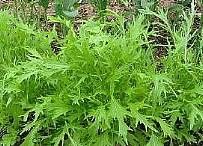 Mizuna
Mizuna
One of the simplest oriental greens, and gives a very rapid return from a small space. An excellent salad crop, tolerant of both hot and cold weather – with a good texture and flavour.
The leaves are ready within 3-4 weeks of sowing, and plants will continue to produce for months. This is a specially quick-growing variety, with deeply cut leaves that give plenty of lift to your salads.
An excellent salad crop year round, being tolerant of both hot and cold weather without bolting.
High returns from a small space.
![]() approx 500 seed (we give you lots so you can sow repeatedly) £
approx 500 seed (we give you lots so you can sow repeatedly) £
When? One of the very few you can sow most of the year without much
risk of it bolting.
Small screen: Turn your device sideways to view sowing calendar.




















































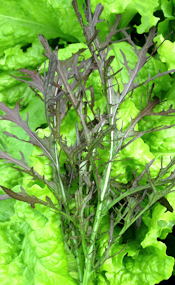 Red Mizuna
Red Mizuna
Tremendously good looking, a vigorous plant with deep red veins and a lighter red blush to the leaves. A brilliant (in all senses of the word) addition to your salad, and very easy to grow.
Apart from the colour it is a normal Mizuna - quick and easy, with leaves ready within 3-4 weeks of sowing, and it continue to produce for months.
An excellent salad crop at many times of the year, being tolerant of both hot and cold weather without bolting, although in hot weather its trace of mustard ancestry (where the red came from) shows up as it can sometimes get slightly spicy in midsummer.
Rare red variant of Mizuna! We offer Organic seed whenever possible.
 - approx 700 seed, organic £
- approx 700 seed, organic £
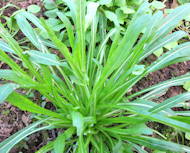 Medium
Mibuna
Medium
Mibuna
A quick and ridiculously easily-grown salad for cooler weather.
Big bunches of narrow oval leaves which you can just pick by the handful. Productive and easy to grow, and also tasty cooked.
![]() approx 300 seed £
approx 300 seed £
Small screen: Turn your device sideways to view sowing calendar.




















































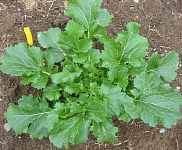 Mispoona
Mispoona
A totally new vegetable we introduced for the first time in 2006, created by Frank Morton by crossing Tatsoi with Mizuna.
We really like it. It combines the bolt-resistance of Mizuna with the big leaves of Tatsoi. You can sow it in spring or midsummer, and it very quickly makes big rosettes of dark green leaves that are delicious raw or cooked.
Every time we grow it we are simply amazed by how quickly and hugely the plants head up. For a sense of scale, the yellow thing in the photo is a standard 4-inch plant label!
Wonderful.. Limited seed every year, so order early.
When? Sow in Spring or after midsummer: like mizuna, it is very tolerant of different sowing times.
Small screen: Turn your device sideways to view sowing calendar.




















































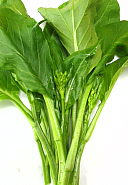 'Tsoi Sim' Japanese Flowering Shoots & Leaves
'Tsoi Sim' Japanese Flowering Shoots & Leaves
An amazing vegetable from Japan, this grows very quickly - ready in just 3 or 4 weeks - giving vividly glowing green leaves and flowering shoots that are great cooked or raw.
All parts of the plant has a fantastic flavour, and it is really easy to grow - pick young when it starts to make flower shoots - just before the flowers open is ideal. Harvest young as it flowers - take whole plants, cook the flower shoots and leaves all together. You’ll need 6 or so for a meal, so we give you quite a lot of seed.
Tsoi Sim runs to seed quicker (a response to lengthening days) if sown early in the year but that’s OK as you’re growing it for the flower stems anyways. So, sow repeatedly at any time, but you’ll get bigger plants if sown after midsummer.
Sow repeatedly at any time, but particularly after midsummer. In late autumn, sow under cover for production over winter.
![]() about 300 seed
£
about 300 seed
£
Small screen: Turn your device sideways to view sowing calendar.




















































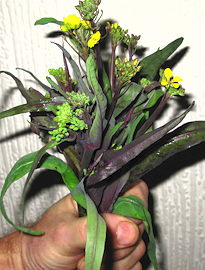 "Welcome" Chinese Flowering Shoots & Leaves (Red-stem)
"Welcome" Chinese Flowering Shoots & Leaves (Red-stem)
This is a new variety we have chosen to complement the green Tsoi Sim above, which is so popular with everyone. It is a fantastic oriental vegetable grown for its flowering shoots, used like sprouting broccoli, but much quicker to grow. This variety has been chosen for its red-purple stem colour.
Use both in salads and cooked. Whole plant is edible - harvest flower shoots and leaves all in a bunch when it starts to flower.
Normally you sow it in late summer, but very early in spring under cover may be worth trying as well.
 1g of seed
£
1g of seed
£
Small screen: Turn your device sideways to view sowing calendar.






















































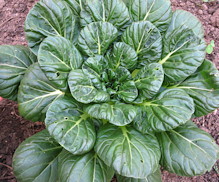
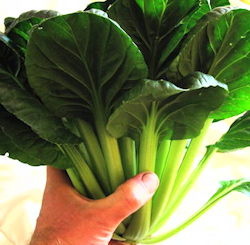 Tatsoi
Tatsoi
Tatsoi is a delicious cooked green that has been bred for its big rosettes of dark green oval leaves, an Asian equivalent of spinach. It has a really good flavour cooked or as baby leaves in salad.
The taste is great and the plants are almost foolproof. If you like Pak Choi, you'll like this too - a similar taste but comes ready sooner. We grow both!
Dark green rosettes, quick and tasty. Normally sown after midsummer but you can sow in spring as well.
 approx 300 seed, organic
£
approx 300 seed, organic
£
Small screen: Turn your device sideways to view sowing calendar.






















































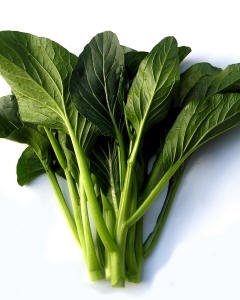 "70 Days Improved" Mid-season Choy Sum
"70 Days Improved" Mid-season Choy Sum
This variety from China is chosen for its darker green leaves and flowering shoots that are great cooked or raw. The whole plant is edible - harvest flower shoots and leaves all in a bunch when it starts to flower - as pictured. Delicious, like broccoli, one of Ben's favourites!
This variety has been selected for being bolt-resistant ,and is also a bit more cold tolerant. Normally sow in late summer, but very early in spring under cover works well too.
Ready about 70 days or so after sowing.
![]() £
£
Small screen: Turn your device sideways to view sowing calendar.






















































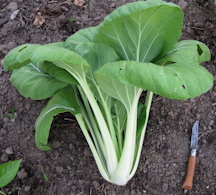 'Tai Sai' White Stem Pak Choi
'Tai Sai' White Stem Pak Choi
A nice discovery in our 2010 trials - a special Pak Choi from Japan, bred for its unusually large and long white stems. It is remarkably bolt-resistant and can be sown in early spring or in midsummer. See Ben's penknife in the photo for a sense of how huge these can get!
The stems are tender and it is quick to grow with a particularly good flavour. It's interesting to see how people in other countries have bred similar vegetables, but starting from different plants; this seems to be the pak-choi equivalent of the large-stemmed Chard that is used in Northern Europe.
We were very sucessful growing this in a greenhouse in early spring, getting large heads by the start of May. We were really impressed by the fact that it didn't run to seed even in the heat.
![]() Tall leaves, long white stems
Tall leaves, long white stems
300 seed £
Small screen: Turn your device sideways to view sowing calendar.






















































don't forget to try the Oriental Mustard Greens which have their own page.
Saving Oriental Vegetable Green Seed
These greens from Japan and China are from the Brassica family (Cabbages, Kales etc) and are really easy to save seed from. Yet another reason to learn to save Brassica seed - it's the same process for all, so learning one thing lets you save lots of different vegetable seed. We would really like to encourage you to have a go at saving seed from this family - that's the cabbages, kales, oriental vegetables, broccoli and turnips.
We know many of you save obvious ones like tomato and lettuce seed, but we've noticed that in the past people shied away from doing the biennial vegetables (plants that flower in their second year).
Cheeringly, more people are emailing us to say they've had a go at saving brassica seed, with good results - and we'd like to encourage you to try it too: its incredibly easy, and you get so much seed, you'll have loads to give away.
There's really no need for example to buy Pak Choi seed from us every year at all. You just set aside a patch of good plants (eat any rubbish ones) , and let them flower, making sure that you've got a reasonable number, that they are healthy, and that no other sorts are flowering nearby that might cross with them. You'll get lots of seed pods in August.
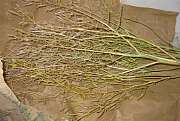
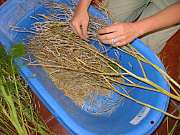
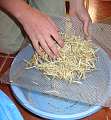

Many of the brassicas (turnips, cabbages, cauliflowers etc) will cross with each other very readily
- so only let one variety flower each year.
Flower stalks from a good-sized population are hung up to dry,
then broken open over a bowl (or old baby bath in this case!).
The bits of pod are screened out with a sieve or a soil riddle
- but you can instead winnow them off in a breeze pretty easily if you prefer.
Step-by-step instructions are here on our new brassica-seed-processing page.
And of course, seed-saving is only possible because these are all real, non-hybrid varieties.
It's pretty foolproof - why not give it a go?






